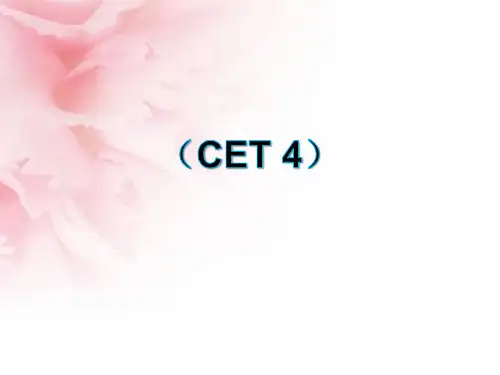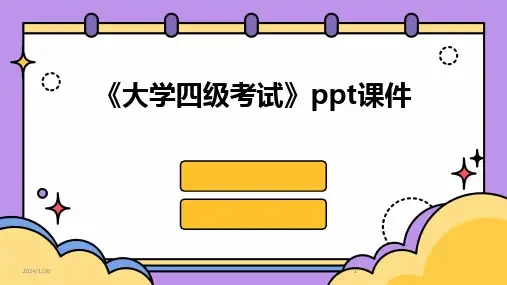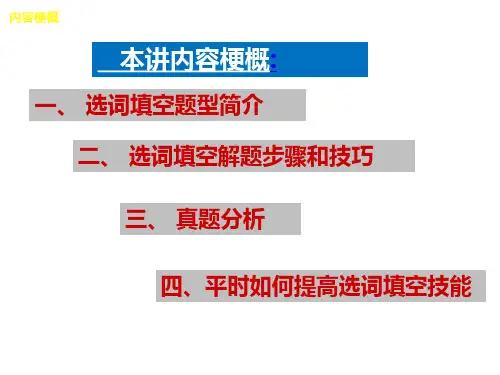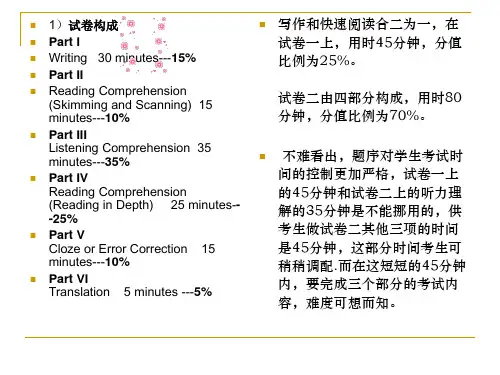最新英语四级题型分析及讲解课件
- 格式:pdf
- 大小:11.51 MB
- 文档页数:69





01阅读理解题型概述Chapter题型特点与分值分布题型多样分值较高时间紧迫占总分的35%,每题分值不等需要在有限的时间内快速阅读并答题包括选择题、填空题、匹配题等历年真题回顾与趋势分析01020301制定详细的备考计划,分阶段进行复习020304多做历年真题和模拟题,提高阅读速度和准确性注重词汇和语法的积累,提高文章理解能力合理安排时间,保证每天有一定的阅读量备考策略及时间安排02词汇与短语积累Chapter01020304制定词汇学习计划上下文记忆法利用词根词缀记忆反复复习与实践高频词汇总结与记忆方法常见短语搭配及用法举例动词短语形容词短语名词短语介词短语同义词辨析和替换技巧同义词辨析替换技巧03句子理解与翻译技巧Chapter01020304快速定位主谓宾,理解句子核心意思。
识别句子主干识别定语从句、状语从句等,明确从句与主句的关系。
分析从句类型将长句拆分成若干短句,逐个理解,再整合全句意思。
拆分长句采用顺译、倒译等方法,保证译文通顺、准确。
翻译技巧长难句结构分析与翻译方法强调句注意省略的部分,根据上下文补充完整意思。
省略句倒装句应对策略01020403熟悉特殊句式结构,通过大量练习提高识别速度和准确性。
识别it was ... that 等强调句型,理解被强调部分的重要性。
识别倒装结构,调整语序以理解句子意思。
特殊句式识别及应对策略理解段落主题快速浏览段落首尾句,把握段落主题和中心思想。
寻找关键词注意转折词、因果词等,理解句子间的逻辑关系。
分析句子间联系理解句子间的并列、转折、因果等关系,把握文章脉络。
预测下文内容根据已知信息,预测下文可能涉及的内容,提高阅读速度。
上下文逻辑关系把握04文章结构分析与主旨把握Chapter文章类型识别及结构特点记叙文01说明文02议论文03段落间逻辑关系梳理转折关系前后段落意思相反或相对,常用转折词有“但是”、“然而”、“尽管如此”等。
因果关系前后段落存在原因和结果的关系,常用因果词有“因为”、“所以”、“因此”等。

学习教案•考试大纲与题型解读•听力理解与技巧提升•阅读理解与答题技巧•翻译技巧与实战演练目•写作指导与范文欣赏•模拟考试与答题卡填涂规范录01考试大纲与题型解读四级考试大纲概述考试目的测试学生英语应用能力,包括听、说、读、写、译等方面。
考试内容涵盖英语词汇、语法、阅读、写作、听力等多个方面。
考试形式采用笔试形式,包括听力、阅读理解、完形填空、翻译和写作等部分。
各类题型分值分布阅读理解部分翻译部分占总分的35%,包括选词填空、长篇阅读和仔细阅读等。
占总分的15%,包括汉译英和英译汉两种题型。
听力部分完形填空部分写作部分占总分的35%,包括短对话、长对话、听力篇章等。
占总分的10%,测试学生综合运用语言的能力。
占总分的15%,测试学生书面表达能力。
考试难度及趋势分析难度逐年提升随着考生英语水平的普遍提高,四级考试难度也在逐年提升。
题型变化多样为了全面测试学生的英语应用能力,四级考试题型也在不断变化和更新。
重视实际应用近年来,四级考试越来越注重测试学生在实际场景中运用英语的能力。
根据自己的实际情况,制定切实可行的学习计划,并严格执行。
制定合理的学习计划利用图书馆、网络等多种渠道获取丰富的学习资源,提高学习效率。
多渠道获取学习资源加强听力和口语训练,提高英语交流能力。
注重听说训练多做历年真题,熟悉考试题型和难度,提高应试能力。
多做真题备考策略与建议02听力理解与技巧提升短对话考查日常生活场景中的交流能力,包括时间、地点、人物、事件等关键信息提取。
长对话考查对较长对话或独白的理解能力,需要把握整体内容和关键细节。
听力篇章考查对整篇文章的把握能力,包括主旨大意、具体细节和推理判断等。
听力部分题型介绍030201听力材料多来源于真实生活场景,如校园、家庭、社会等。
真实场景四级考试听力语速适中,符合一般英语交流速度。
语速适中听力材料难度适中,既不会过于简单也不会过于复杂。
难易适中听力材料特点分析预测法根据题干和选项预测听力材料内容,提高听的目的性和针对性。

课件•Overview of question types andproblem solving strategies•Tips for solving detail comprehensionproblems目•The method of solving the main ideaproblem录•Strategies for solving reasoning andjudgment problems•How to deal with vocal comprehensionquestions目•Sentence fill in the blank questionanswering skills录01Overview ofquestion typesand problemsolvingstrategiesThese are the most common type of questions in CET-4 reading comprehension, requiring students toselect the best answerfrom multiple options MultipleChoiceQuestionsStudents must determine which statement is true orfalse based on the information provided inthe passage True or False Questions These questions test students' understanding of specific details or concepts by asking them to complete a sentence or paragraph with the correct information Fill in the blank Questions Students must match items from two different lists, such as matching heads with paragraphs or matching definitions with termsMatching Questions Introduction to CET-4 Reading Question TypesGeneral problem solving strategies•Skimming and Scanning: Skimming investments quickly reading the passage to get a general understanding of the main idea, while scanning investments searching for specific information or keywords•Understanding Question Types: Familiarizing yourself with the different types of questions and understanding what each type is asking for can help you approach the passage more effectively •Identifying Key Information: Learning to identify key information in the passage, such as the main idea, supporting details, and the author's purpose or title, is critical for answering questions correctly •Eliminating Incorrect Answers: Narrowing down your options by eliminating answers that are clearly incorrect can help you focus on the most likely correct answersTime management and answering sequence•Allocation Time: It is important to allocate your time willingly when taking the CET-4 reading comprehension section Determine how much time you have for each pass and question, and stick to your plan•Reading the Questions First: Sometimes it can be helpful to read the questions before reading the passage, as this can give you a better idea of what information you should be looking for •Answering Easy Questions First: If you come across a question that seems particularly difficult, it may be best to skip it and come back to it later Answering the eastern questions first can help you build confidence and momentum•Reviewing Your Answers: After you have finished answering all the questions, take a moment to review your answers and make sure that you have not missed any objective misses02Tips forsolving detailcomprehension problemsIdentify key information and vocabularyPay attention to nouns, ve…These word classes often contain important information and help tounderstand the main idea of the textLook for key phrases and presence structuresKey phrases and presence structures can provide clubs to the meaning of thetext and help to locate important information quicklyBe aware of synonyms and antonymsUnderstanding synonyms and antonyms can help to understand the meaningof words in context and avoid misunderstandingsPositioning the original text and answer areaRead the question carefull…Before looking for the answer in the text, it is important to understand whatinformation is being asked forScan the text quickly to locate relevant informationOnce the key information in the question has been identified, scan the textquickly to find the relevant sectionRead the relevant section carefully to find the answerAfter locating the relevant section of the text, read it carefully to find theanswer to the questionTechniques for identifying interference itemsEliminate objectively incorrect optionsSometimes there will be objectively incorrect options that can be identifiedimmediatelyCompare and contrast similar optionsIf there are multiple similar options, compare and contrast them to find the onethat best fits the information in the textUse determination method to arrow down choicesIf there are still several possible answers after identifying objectively incorrectoptions, use the determination method to arrow down the choices furtherExample analysis and practiceAnalyze example questions and answersLooking at example questions and answers can help understand how to apply the tips andtechniques learned in this sectionPractice with real CET-4 questionsPracticing with real CET-4 questions is essential for training confidence and improving problemsolving skillsReview and reflect on performanceAfter practicing, review your answers and reflect on your performance to identify areas forimprovement03The method ofsolving themain ideaproblemRead the title and subtitle to get a general idea of the content Skim through the articlequickly to grasp the mainpoints and structureIdentify the topic presenceof each paragraph tounderstand the main idea ofeach sectionDetermine the central idea of the articlePay attention to keywords that are repeated or emphasized in the textAnalyze the logical relationship between paragraphs to understand the connection betweenideasLook for topic senses at thebeginning or end of eachparagraphIdentify paragraph topic senses and keywordsSummarize the main idea of the article in your own words Identify the author's purposeand attitude towards thetopicAnalyze the languagefeatures and rhetoricaldevices used by the author toconvey the messageSummarize the main idea and techniques of the entire textExample analysis and practiceAnalyze sample questions and answers to understand the question typesand answering techniquesPractice solving main idea problems with different articles and questiontypesReflect on your own answers and compare them with the correct answers toidentify areas for improvement04Strategies forsolvingreasoning andjudgmentproblemsUnderstand the author's viewpoint and titleIdentify key senses and words01Look for topic senses, including senses, and words withemotional color to understand the author's viewpoint and titleAnalyze the author's argument02Examine the evidence and reasoning the author uses to supporttheir viewpoints, and identify any assumptions or biasesAdvisor the author's background03Take into account the author's expertise, experience, and anypotential conflicts of interest that may affect their viewpointInferring implied information or conclusionsRead between the linesLook for hints or clubs in the text that suggests whatthe author may be implying but not directly statingUse logical reasoningApply logical reasoning skills to draw conclusionsbased on the information provided in the textAdvisor the overall contextTake into account the larger context of the text,including the author's purpose and intendedaudience, to infer implied information or conclusionsIdentify facts andopinionsDistinguish between facts and opinions in the text, and determine which are relevant to the question at hand Evaluate evidenceand reasoningAssess the quality andeffectiveness of the evidenceand reasoning provided tosupport a specific viewpointor conclusionProvide reasonsand explanationsClearly explain why a specificanswer is correct or incorrect,and provide evidence andreasoning to support youranswerDetermine right and wrong and provide reasonsAnalyze samplequestionsExamine sample questions and answers to understand the types of reasoning and judgment problems you may account for on the CET-4 exam Identify commonmissesLook for common misses madeby students when solving thesetypes of problems, and learn howto avoid themPractice solvingproblemsPractice solving reasoning andjudgment problems using thestrategies you have learned, andseek feedback on your answers toimprove your skills010203 Example analysis and practice05How to dealwith vocalcomprehension questionsTechniques for guiding the meanings of unfriendly wordsWord formationUnderstanding word roots,prefixes, and suffixes can helpguide the meanings of unknownwordsWord associationAssociating unfriendly words withknown words or concepts can aidin comprehensionUsing examples Looking for examples orillustrations that account forunfamily words can clarify theirmeaningsUsing contextual clues to infer word meaningsReading the presence or pa…Understanding the context can provide includes to the word's meaningPaying attention to grammar and syntaxThe structure of the presence or paragraph can give hints about the meaningof unfriendly wordsConsidering the overall theme or topicUnderstanding the browser theme or topic of the text can help infer themeanings of specific words1 2 3Looking for words or phrases that have similar meanings to the unfriendly word can be aid in comprehensionSearching for synonymsA Thesaurus is a useful tool for finding synonyms and antonyms of unknown words Using a ThesaurusTrying to rephrase the presence containing the unfriendly word can help identify a suitable synonymRephrasing the presenceIdentify synonyms or synonym replacements01 02 03Analyzing sample questionsLooking at sample vocabulary comprehension questions and answers can help understand the types of questions that may be askedPracticing with real CET-4 materialsUsing authentic CET-4 reading materials for practice can help familiarize yourself with the vocabulary and question typesTimed practice sessionsSetting timed practice sessions can help improve speed and accuracy when dealing with vocal comprehension questions during the actual examExample analysis and practice06Sentence fill inthe blankquestionansweringskillsAnalyze sensitivity structure and determine the type of fill in the blankIdentify the subject, predict, andobject of the presence tounderstand its basic structureDetermine the type of fill in theblank, such as noun, verb,advisory, or advisory, based onthe presence structure andcontext Pay attention to any hints or clubs provided by the presence, such as positions, connections, or junction marksChois单击此处添加正文,文字是您思想的提炼,为了最终呈现发布的良好效果,请尽量言简意赅的阐述观点;根据需要可酌情增减文字,以便观者可以准确理解您所传达的信息,请尽量言简意赅的阐述观点;根据需要可酌情增减文字,以便观者可以准确理解您所传达的信息。



